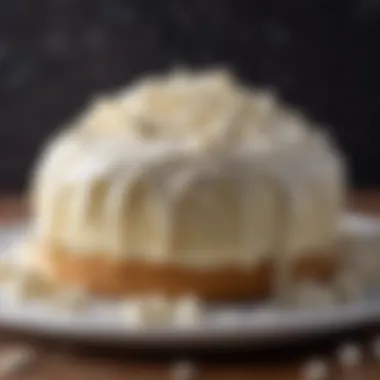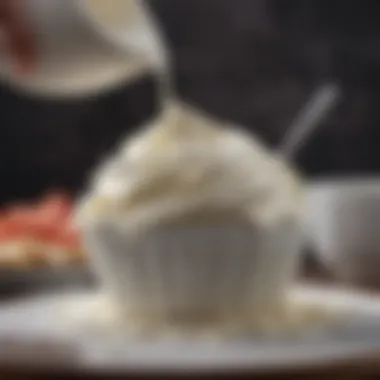Master the Art of Cream Cheese Icing from Scratch


Intro
Making your own cream cheese icing from scratch can elevate your baking to a new level. Its creamy texture and rich flavor make it a popular choice for cakes, cupcakes, and other desserts. This guide aims to equip you with all the necessary information to create delicious, homemade cream cheese icing. The journey through ingredient selection, tools needed, and common challenges will help you appreciate this versatile icing more.
Cream cheese icing is not just for basic desserts. It enhances a variety of flavors, adding a slight tang that balances sweetness perfectly. Whether you want to create classic combinations or experiment with unique flavors, this icing is adaptable and straightforward to make.
By the end of this article, you will have gained a thorough understanding of the cream cheese icing-making process. From selecting quality ingredients to mastering techniques, you will be able to navigate any challenges with confidence.
Recipe Overview
Recipe Name and Description
Cream Cheese Icing is a smooth, creamy topping made primarily from cream cheese and sugar. Its soft texture and tangy flavor make it perfect for pairing with many cakes, especially carrot, red velvet, and chocolate cakes.
Cuisine Type
This icing is commonly found in American cuisine, often served at celebrations and festive occasions.
Ingredients List
Detailed Ingredient Breakdown
To make a standard cream cheese icing, you will need:
- 8 ounces of cream cheese: It is crucial to use full-fat cream cheese for the best texture and flavor.
- 4 tablespoons of unsalted butter: Softened, to mix smoothly with the cream cheese.
- 2 to 3 cups of powdered sugar: This will determine the sweetness level and thickness.
- 1 teaspoon of vanilla extract: For added aroma and flavor.
- A pinch of salt: To balance the sweetness.
Substitutions for Dietary Needs
If you have dietary restrictions, consider the following substitutions:
- Cream Cheese: Use a dairy-free cream cheese alternative for a vegan option.
- Butter: Substitute with coconut oil or a vegan spread.
- Powdered Sugar: You can create powdered sugar from regular sugar by grinding it in a blender, suitable for whole food diets.
Understanding the components of cream cheese icing can help you make it perfectly to your liking.
Incorporating these ideas into your baking repertoire will expand the range of desserts you can prepare. Stay tuned as we delve into detailed instructions, techniques, and additional variations of cream cheese icing.
Intro to Cream Cheese Icing
Cream cheese icing plays a significant role in the world of baking and dessert preparation. Recognizable by its creamy texture and slightly tangy flavor, this icing is not just a topping but an essential component that can elevate many baked goods. Understanding how to make cream cheese icing from scratch is an important skill for home bakers and culinary enthusiasts alike. It not only allows for customization in flavor and sweetness but also ensures freshness and quality that is often lacking in store-bought alternatives.
Making cream cheese icing is a straightforward process that can be tailored to individual preferences. This purity of preparation enables bakers to control the ingredients used, addressing dietary restrictions and personal taste preferences, which can maximize enjoyment. As a versatile option, cream cheese icing can be paired with a variety of desserts. Knowing its uses and how to produce it efficiently can lead to surprising results and satisfying flavors.
What is Cream Cheese Icing?
Cream cheese icing is a sweet frosting made primarily from cream cheese and butter, combined with powdered sugar and flavorings such as vanilla extract. The basic components create a smooth and creamy texture, which is perfect for spreading or piping on cakes and other desserts. The key ingredient, cream cheese, provides a rich, slightly tangy flavor that distinguishes this icing from others like buttercream or fondant.
The process of making cream cheese icing involves simple methods, yet the technique can vary depending on the desired texture and taste. Most commonly, bakers choose to use full-fat cream cheese to achieve the best flavor profile and richness.
Purpose and Uses
The purpose of cream cheese icing extends beyond just being a sweet topping. It complements a wide array of baked goods, making it a beloved choice for many. Here are several notable purposes and uses for cream cheese icing:
- Topping for Cakes: Many cakes, particularly carrot and red velvet cakes, are paired with cream cheese icing to enhance their flavors.
- Cupcake Filling: It can be piped into cupcakes providing a delightful surprise in the center.
- Piping Decoration: Its consistency makes it suitable for decorating pastries and cookies.
- Flavor Balloon: The slight tanginess of cream cheese can help balance out the sweetness of cakes and desserts.
- Versatility: Beyond traditional uses, cream cheese icing can also be adapted with various flavorings or colorings, allowing for creative experimentation.
Ingredients Required
The selection of ingredients significantly impacts the final taste and texture of the cream cheese icing. Understanding each component and its role can enhance not only the icing's flavor but also its spreadability and overall appeal. Using high-quality ingredients is crucial for producing a creamy, well-balanced icing.
Primary Ingredients
Cream cheese
Cream cheese is the fundamental ingredient in this icing. Its creamy texture and tangy flavor offer a perfect balance to the sweetness of the sugar. The key characteristic of cream cheese is its ability to blend smoothly with other ingredients, creating a uniform icing without lumps. This makes it a popular choice for bakers. One unique feature of cream cheese is its requirement for refrigeration, which can impact the preparation time. Additionally, when using cream cheese, it is advisable to allow it to reach room temperature before mixing to achieve a smoother consistency.
Butter
Butter serves as another essential component, contributing to both flavor and texture. The key characteristic of butter is its rich taste, which complements the cream cheese and adds a layer of depth to the icing. This choice enhances the creaminess of the mixture, making it easier to spread and pipe. One advantage of using butter is that it blends well, contributing to a smooth finish. However, care must be taken with the temperature; if too warm, butter can cause the icing to become too soft.
Powdered sugar


Powdered sugar plays a vital role in sweetening the icing. Its fine texture allows it to dissolve quickly and evenly, preventing the gritty mouthfeel that granulated sugar might impart. The key aspect of powdered sugar is its ability to create volume while maintaining a creamy texture. This makes it a beneficial choice for icing. However, it can be easy to overdo the sweetness, which might overshadow the cream cheese flavor. Gradually adding the powdered sugar helps achieve the desired sweetness.
Vanilla extract
Vanilla extract is an optional yet impactful ingredient, enhancing the overall flavor profile of the icing. The aromatic quality of vanilla complements the tanginess of the cream cheese. The key characteristic of vanilla extract is its ability to provide depth and richness without being overpowering. Adding a small amount can transform the icing significantly. However, one should be cautious not to use too much, as the strong flavor can dominate the more subtle notes of the cream cheese and butter.
Optional Additives
Flavorings
Beyond the primary ingredients, flavorings can personalize the icing to suit various tastes. Common options include lemon zest, almond extract, and even coffee. Each flavor has its unique characteristics that can elevate the mundane cream cheese icing to something distinct and exciting. One advantage of using flavorings is the ability to cater to personal preferences or match specific baked goods. However, one must be careful to balance these additions to avoid overpowering the icing’s natural flavor.
Colorings
Colorings are optional but can enhance the visual appeal of the icing. Food coloring can be used to create vibrant hues, making the icing more alluring, especially for celebrations. The key attribute of colorings is their ability to transform the appearance without affecting the taste. Using colorings allows for creativity, especially when decorating cakes or cupcakes. Nevertheless, it's important to use them sparingly, as too much can lead to unnatural appearances.
Essential Tools for Preparation
To create a perfect cream cheese icing, having the right tools is crucial. These essential implements not only streamline the process but also ensure that all ingredients are mixed properly, contributing to the desired texture and flavor. The right equipment can make the difference between a delightful icing and one that fails to meet expectations. Below are the key types of tools that one should consider in the preparation of cream cheese icing.
Mixing Equipment
Hand mixer
A hand mixer is a fundamental tool in any home kitchen. Its portability allows for easy handling, and it is particularly useful for small batches of cream cheese icing. The key characteristic of a hand mixer is its ability to mix ingredients thoroughly without requiring extensive arm work. This feature makes it a beneficial choice for those who may not want to invest in bulkier equipment.
The unique feature of a hand mixer is its variety of speed settings. This allows users to gradually increase mixing speed, which is crucial when incorporating powdered sugar to prevent a mess. However, one disadvantage is that it may struggle with very thick mixtures, leading to potential inefficiency for larger batches.
Stand mixer
The stand mixer takes mixing to a different level altogether. Its powerful motor is designed to handle denser mixtures with ease. The stand mixer is a popular choice due to its hands-free operation. This allows the user to multitask while ingredients are being mixed.
One unique feature is the attachments available for a stand mixer, such as a paddle attachment designed specifically for cream cheese icing. This can yield a smoother finish. However, its size can be a disadvantage for those with limited kitchen space. Additionally, the investment cost might be higher compared to simpler tools.
Spatula
A spatula is an often-overlooked tool, yet it has significant importance in the preparation of cream cheese icing. It is primarily used for folding ingredients and ensuring even mixing. The flexibility of a spatula allows it to easily scrape down the sides of bowls, which helps to incorporate every bit of cream cheese and sugar into the mixture.
What makes a spatula a beneficial choice is its ability to reach every corner of the mixing bowl, ensuring no ingredient is left behind. However, it requires a little effort to mix ingredients thoroughly, especially when working with denser mixtures. A spatula cannot replace the mixing tools but should be used in conjunction with them for better results.
Measuring Tools
Accurate measurement is vital in achieving the right balance of flavors and textures in cream cheese icing. Using the correct measuring tools aids in maintaining consistency, which is important for reliable results.
Measuring cups
Measuring cups are essential for accurately measuring ingredients, especially for dry items like powdered sugar. Their design enables them to hold specific volumes, ensuring that each ingredient is precisely measured. This is a beneficial aspect as it relates to the balance of flavors in the icing.
One unique feature of measuring cups is the marked measurements on the side, which provide ease of use. However, a potential disadvantage is that they may not work well with very small quantities, which sometimes is necessary for certain adjustments in the icing recipe.
Measuring spoons
Measuring spoons play a critical role, particularly for measuring smaller amounts of ingredients like vanilla extract. Their small size allows for precision in flavoring, which is often needed to enhance the overall taste of the icing without overpowering it. This detail can significantly affect the final outcome, making measuring spoons an indispensable tool in the process.
The unique characteristic of measuring spoons is their nested design, allowing for easy storage without taking up much space. However, using them can be cumbersome when dealing with larger quantities, requiring multiple spoonfuls instead of a single measurement.
Remember, the accuracy of your ingredients directly impacts the texture and flavor of your cream cheese icing. Every tool has its place in this endeavor.
Step-by-Step Preparation
The process of making cream cheese icing is straightforward but requires attention to detail. This section emphasizes the critical steps involved in preparation, ensuring optimal results. Proper preparation leads to a silky-smooth icing that enhances your baked goods. A structured approach allows for consistency and quality, enabling you to enjoy the satisfaction of achieving a creamy and delectable final product.
Preparing Your Cream Cheese
To start, selecting the right cream cheese is vital. Look for a full-fat cream cheese, as it offers richer flavor and creates a velvety texture in the icing. Before mixing, your cream cheese should be at room temperature. This makes it easier to blend smoothly with other ingredients. If cold cream cheese is used, the mixture may become lumpy and difficult to work with. Allowing it to warm up can take about 30 minutes at room temperature. To streamline the process, you can cut the cream cheese into smaller cubes. This approach speeds up the warming process and eases the mixing.
Once at room temperature, place the cream cheese in a bowl. Use a hand mixer or stand mixer to beat it until it becomes fluffy and pale. This step introduces air into the mixture and enhances the resulting texture. Aim for a light consistency before proceeding.
Mixing Ingredients Together
The next step is to add the other key ingredients: softened butter, powdered sugar, and vanilla extract. Each of these elements plays a role in flavor and consistency. Softened butter should also be at room temperature. Beat it together with the cream cheese until completely combined. Incorporating the butter properly will further develop the texture of the icing.


When adding powdered sugar, do so gradually. This helps prevent clouding the kitchen and allows for a smoother mix. Mix at low speed to ensure it combines well before increasing the speed as the sugar begins to blend in. Powdered sugar provides the necessary sweetness and thickness, while vanilla extract adds a delightful aroma and flavor.
As you mix, scrape down the sides of the bowl with a spatula to ensure all ingredients are well combined. Continue to mix until you achieve a homogeneous mixture with no lumps. This part of the preparation is critical; any unincorporated clump can detract from the texture of the icing.
Achieving the Ideal Consistency
After mixing, assess the consistency of your icing. The texture should be smooth and spreadable, not too runny. If it appears too thick, it may benefit from a few teaspoons of milk or heavy cream. Add liquid slowly and mix until desired consistency is achieved. On the other hand, if the icing seems too thin, adding a little more powdered sugar can help to thicken it.
The ideal cream cheese icing is versatile. It can be spread on cakes, piped on cupcakes, or used in other creative applications. This icing can also be adjusted based on personal preference. For those who desire a firmer icing, chilling it in the refrigerator for a short time can enhance its structure. Always taste and adjust the sweetness according to your preference, ensuring balance in flavors.
Remember: The success of your cream cheese icing relies heavily on the careful preparation of each ingredient, attention to mixing, and adjusting for the right consistency.
Common Challenges and Solutions
Making cream cheese icing may seem straightforward, yet several challenges arise during the preparation process. Understanding these challenges is essential for achieving perfect results. This section will focus on issues that commonly occur with consistency and flavor, providing clear solutions to enhance your icing-making experience.
Issues with Consistency
Consistency is crucial for cream cheese icing, as it affects both appearance and application. An icing that is too thin will not hold its shape, making it difficult to spread or pipe onto cakes and pastries. Conversely, if the icing is too thick, it can become hard to mix and may lack the creamy texture desired.
To address issues with consistency, consider the following tips:
- Temperature of Ingredients: Ensure both the cream cheese and butter are at room temperature. Cold ingredients can lead to a lumpy mixture.
- Powdered Sugar Gradually: Add powdered sugar slowly while mixing. This helps prevent clumping and allows for better control over the icing's thickness.
- Adjusting Liquid: If your icing is too thick, adding a teaspoon of milk or cream can help reach the desired consistency. Be cautious with this adjustment. It's easier to add than to remove.
If you've ended up with runny icing, adding additional powdered sugar might help thicken it. However, keep in mind that this may alter the flavor, requiring adjustments to the taste ingredients.
Flavor Imbalance
A great cream cheese icing should have a balanced and harmonious flavor. An imbalance may occur if any ingredient overshadows the others, resulting in either an overly sweet or bland icing.
To avoid flavor imbalance, consider the following practices:
- Quality of Ingredients: Use high-quality cream cheese and fresh butter. The flavor of the main ingredients heavily influences the final product.
- Taste Testing: As you mix, taste your icing and make adjustments gradually. Often, a small amount of additional vanilla extract or a pinch of salt can enhance overall flavor without overpowering.
- Flavor Variations: Experimenting with added flavorings, like lemon zest or cocoa powder, can add complexity to your icing. Remember, less is often more. Start with small amounts and adjust according to your preferences.
In summary, being aware of the potential challenges in consistency and flavor allows for more successful icing preparation. Embracing these considerations will help you create a cream cheese icing that is not only pleasing in texture but also delightful in taste.
Variations of Cream Cheese Icing
Cream cheese icing is not only beloved for its creamy texture and tangy flavor, but it also serves as a foundation for countless variations. Exploring these variations allows home bakers to enhance their sweet treats in unique ways. By understanding the distinct qualities of each type, you can make an informed choice based on the type of dessert or occasion at hand. These variations not only add delightful flavors but also elevate the aesthetic appeal of your confections, making them suitable for various celebrations and personal preferences.
Chocolate Cream Cheese Icing
Chocolate cream cheese icing combines the rich taste of chocolate with the tangy notes of cream cheese. This variation is particularly favored for its balance of flavors, making it a popular choice for chocolate cakes, brownies, or cupcakes. When preparing chocolate cream cheese icing, it is crucial to select high-quality cocoa powder or melted chocolate. Doing so will ensure that the chocolate flavor shines through without overpowering the naturally creamy base.
To make chocolate cream cheese icing:
- Start with your regular cream cheese icing recipe as a base.
- Gradually mix in cocoa powder or melted chocolate until you achieve the desired chocolate intensity.
- Taste the icing as you go, adjusting sweetness with powdered sugar or other sweeteners as needed.
The resulting icing is not only rich and satisfying but also pairs well with an array of desserts, from simple sponge cakes to more decadent offerings. Be sure to use it promptly, as darker icings can dry out if exposed to air for too long.
Fruit-Based Cream Cheese Icing
Fruit-based cream cheese icing introduces a refreshing twist that is perfect for lighter cakes or seasonal desserts. By incorporating pureed fruits or fruit extracts, bakers can achieve flavors such as strawberry, raspberry, or lemon-infused icing. The key lies in balancing the sugar content and ensuring the mixture retains a smooth consistency while providing the intended fruity flavor.
To make fruit-based cream cheese icing:
- Use fresh or frozen fruits to create a puree.
- Strain the puree to remove seeds and pulp for a smoother icing.
- Gradually add the fruit puree to your basic cream cheese icing.
- Adjust thickness and sweetness as necessary by adding more powdered sugar or a bit of milk if needed.
This variation not only adds vibrant color but also a unique taste that contrasts well with heavier cakes. It is especially appealing in the summer months or at outdoor gatherings, bringing lightness and refreshment to your dessert table.
In both chocolate and fruit-based variations of cream cheese icing, experimentation is welcomed. Adjusting the amounts or trying different fruit combinations can lead to personal favorites that cater to individual tastes. Regardless of the choice, these variations provide both versatility in application and an opportunity for bakers to express their creativity.
Applications in Baking
Cream cheese icing plays a pivotal role in the realm of baking, providing not only flavor but also texture and visual appeal. This icing is prized for its versatility and compatibility with a wide array of baked goods. Understanding its applications can vastly enhance your baking experience and results.
Pairing with Cakes
When it comes to cakes, cream cheese icing is often the top choice for many bakers. The rich and tangy flavor of the icing complements various cake flavors, especially red velvet and carrot cake. This icing's creamy texture adds a luxurious mouthfeel, making each bite enjoyable.
Using cream cheese icing as a cake topper creates a beautiful contrast, especially when paired with dark chocolate or fruity layers. Moreover, applying a generous layer can hide imperfections in cake layers, allowing even novice bakers to present cakes that look professionally made.
Bakers should consider the cake's flavor profile when choosing cream cheese icing. Here are a few combinations:


- Red Velvet Cake: The classic pairing enhances the chocolate notes.
- Carrot Cake: The spiced flavors harmonize well with the icing's creaminess.
- Chocolate Cake: The tangy icing cuts through the sweetness and richness, creating balance.
Using as a Filling
Cream cheese icing is not limited to a mere topping; it serves excellently as a filling. This versatility allows bakers to incorporate the unique flavor into the interior of cakes and pastries as well. For example, in layered cakes, spreading or piping cream cheese icing between layers ensures that each slice delights with flavor.
Moreover, using cream cheese icing as a filling for pastries, like cinnamon rolls or doughnuts, transforms these treats into something special. When warm pastries are filled with cream cheese icing, it can create a melt-in-your-mouth experience. Here are some tips for using it as a filling:
- Ensure the icing is not too soft. A firmer consistency will hold up better when layered or piped.
- Consider flavor variations to match the pastry, such as adding citrus zest for a refreshing kick.
- Use it in pastries like cupcakes or muffins for an unexpected surprise when tasted.
Utilizing cream cheese icing in various applications can significantly elevate the overall experience of your baked goods, making them more intriguing and flavorful.
Storage and Shelf Life
Understanding the storage and shelf life of cream cheese icing is essential for anyone looking to maximize the freshness and flavor of this delightful frosting. Cream cheese icing can be a key element in many baking endeavors, and proper storage techniques are crucial. If not stored correctly, the icing can quickly degrade, losing both its texture and taste. Effective storage methods can extend its usability, allowing home cooks to enjoy the icing until the last drop. This section will guide you in maintaining the quality of your cream cheese icing.
Best Practices for Storage
To ensure that your cream cheese icing remains fresh and delicious, consider following these best practices:
- Refrigeration: Always store cream cheese icing in the refrigerator. The cool temperature slows down the growth of bacteria, which is important due to the dairy content in cream cheese.
- Use an Airtight Container: Transferring the icing to an airtight container helps prevent the icing from absorbing odors from the fridge. It also minimizes moisture loss, which is key in retaining the icing's creamy texture.
- Saran Wrap: If you choose not to use an airtight container, tightly cover the icing with plastic wrap. Make sure it touches the surface of the icing to limit exposure to air.
- Freezing: If you have large batches of icing left, freezing can be an option. Use freezer-safe containers, allowing some space for expansion. When you are ready to use it again, thaw it in the refrigerator overnight.
By being careful about how you store cream cheese icing, you will greatly enhance its shelf life.
Determining Freshness
Recognizing when your cream cheese icing is still safe to use is crucial. Here are some ways to determine the freshness:
- Visual Check: Inspect the icing for any discoloration or a watery layer on top. If you see visible changes, it might be time to discard it.
- Smell Test: A sour or off odor indicates spoilage. Fresh cream cheese icing should have a pleasant, creamy smell.
- Texture Examination: If the icing has separated or turned grainy, it may no longer be usable. Good icing should be smooth and creamy.
- Taste Test: If you’re still unsure, a small taste can help determine if the flavor is still intact. However, do this last and only if other factors seem normal.
By mastering these storage techniques and knowing how to identify fresh icing, you can enjoy the deliciousness of cream cheese icing for longer periods, enhancing your baking experiences.
Nutritional Aspects
When making cream cheese icing, understanding its nutritional value is essential for informed dietary choices. Many of us enjoy sweets, but awareness of what we consume helps in balancing indulgence with health. This section explores the caloric content of cream cheese icing and offers alternatives to make this popular topping healthier.
Caloric Content
The caloric content in cream cheese icing largely comes from its primary ingredients. Cream cheese, butter, and powdered sugar contribute significantly to the total calories. For example, just one cup of cream cheese can provide around 400 calories, and adding butter can increase that number further. Similarly, powdered sugar adds approximately 490 calories per cup. Therefore, if you are mindful about calorie intake, it is beneficial to evaluate portion sizes when using this icing.
An average serving of cream cheese icing (about two tablespoons) can range from 100 to 150 calories. This variation depends on how much sugar and butter are used, as well as any additional flavorings or ingredients. Monitoring these numbers is advised if you are keeping a calorie count or managing your diet.
Possible Modifications for Healthier Options
While cream cheese icing is delicious, it can be adapted to suit various dietary preferences or health goals. Consider these modifications:
- Use Low-Fat Cream Cheese: Opting for low-fat cream cheese can reduce calorie count while maintaining flavor.
- Sweetener Alternatives: Instead of powdered sugar, consider using alternatives like stevia or erythritol. These can decrease caloric intake without sacrificing sweetness.
- Add Greek Yogurt: Incorporating Greek yogurt in place of some cream cheese adds protein and reduces fat content.
- Open to Flavorings: Natural flavorings, such as vanilla extract or cocoa powder, can enhance the taste without contributing significant calories.
- Portion Control: Smaller portions can allow for enjoyment without overwhelming caloric intake.
Making these adjustments can help maintain the integrity of your baking while being more considerate of nutritional aspects. When you experiment with these alternatives, keep in mind the essence of flavor and texture that defines cream cheese icing.
"Creativity in the kitchen often leads to delightful discoveries that can elevate traditional recipes while being mindful of health."
Finale
Understanding the intricacies of making cream cheese icing is vital for anyone looking to enhance their baking experience. This article has covered several salient aspects, including the necessary ingredients, tools, and practical tips to perfect this rich and flavorful icing. One of the main benefits of mastering cream cheese icing is its versatility. From topping cakes to filling pastries, its applications are numerous and suitable for various occasions.
Considering the balance of flavors and textures is another crucial element discussed in this guide. Cream cheese icing can elevate simple recipes into gourmet experiences. Whether you are creating a classic carrot cake or experimenting with a fruit-packed dessert, this icing will enhance and complement your creations. Furthermore, the exploration of optional additives opens the door to personalization, allowing home bakers to adapt recipes to suit specific tastes or themes.
Ultimately, this conclusion encapsulates the intimate relationship between knowledge and practice. By grasping the concepts discussed, home cooks and baking enthusiasts can craft a cream cheese icing that is not only aesthetically pleasing but also a pleasure to taste. Mastery in this realm is not just about following a recipe; it is about developing a skill that brings a sense of satisfaction and creativity to the art of baking.
Final Thoughts on Cream Cheese Icing
Cream cheese icing stands out as a beloved topping due to its unique balance of tangy and sweet flavors. Its creamy consistency adds decadence to many desserts. One cannot overlook the variety of recipes that can incorporate this icing. Each batch offers potential for unique flavors and textures, depending on the specifics of the recipe and ingredients used.
Exploring cream cheese icing can lead to new heights in baking. Therefore, it encourages bakers to view each creation as an opportunity to learn and develop their flavor palette further.
Encouragement for Experimentation
Experimentation is pivotal in baking. While recipes are essential, they are merely starting points. Trying new flavors and making small adjustments can yield exciting results. For example, consider adding citrus zest or using different types of extracts. Such modifications can dramatically alter the flavor profile of the icing.
Baking should be seen as a creative process. Do not shy away from making variations that cater to personal preferences. Whether adjusting sweetness levels or incorporating complementary flavors, the journey of perfecting cream cheese icing is one that promises rich rewards for those who dare to explore.
"A recipe is merely a starting point; your creativity can transform it into something extraordinary."
Encourage yourself to play with textures and even appearance. Color can enhance the visual appeal of your desserts, making them more enticing. The joy of baking comes in being able to experiment and share your findings with friends and family.
In summary, the conclusion is not just an end; it is an invitation to continue exploring, tasting, and creating in the world of baking with cream cheese icing as a companion.















